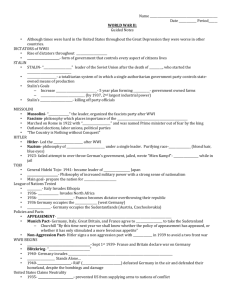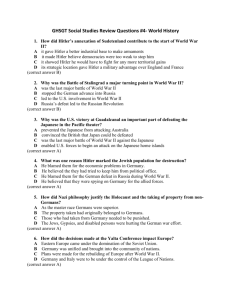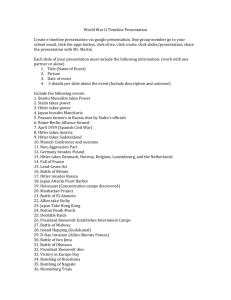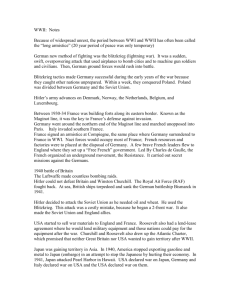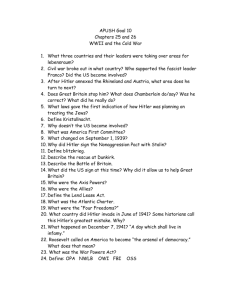WORLD WAR II - Aurora City School District
advertisement
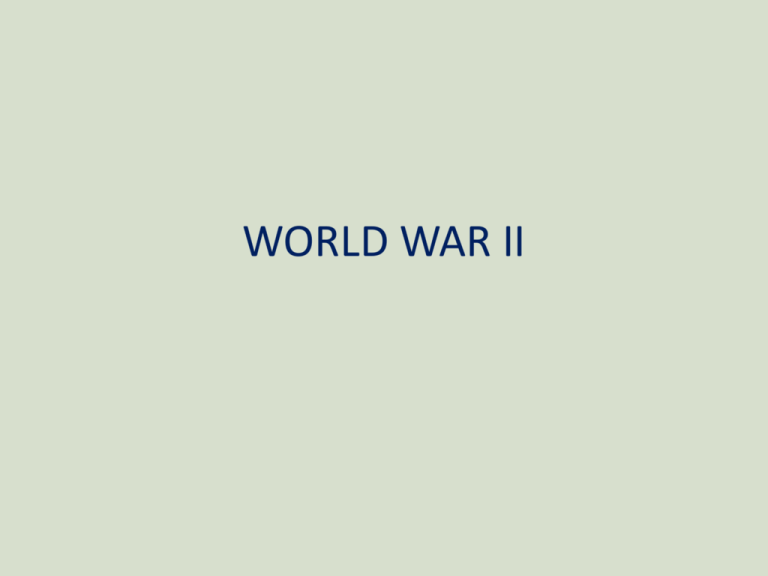
WORLD WAR II World War II Although times were hard in the United States throughout the Great Depression they were worse in other countries. DICTATORS of WWII • Rise of dictators throughout Europe • Totalitarian- form of government that controls every aspect of citizens lives LEADER COUNTRY STALIN MUSSOLINI HITLER TOJO Soviet Union Italy Germany Japan Form of Government Communism Fascism Nazism Militarism • STALIN- “man of Steel” leader of the Soviet Union after the death of Lenin, who started the Communist Party • Communism- a totalitarian system of in which a single authoritarian government party controls state-owned means of production • Stalin’s Goals – Increase Agricultural Production5 year plan forming collectivesgovernment owned farms – Modernize Industry (by 1937, 2nd largest industrial power) • Stalin’s Great Purge- killing off party officials • http://www.youtube.com/wat ch?v=SGUEaFElzRY STALIN MUSSOLINI • Mussolini- “Il Duce” the leader, organized the fascists party after WWI • Fascism- philosophy which places importance of the nation above the value of the individual • Marched on Rome in 1922 with “black shirts” and was named Prime minister out of fear by the king • Outlawed elections, labor unions, political parties • “The Country is Nothing without Conquest” • http://www.youtube.com /watch?v=hIxAsangFZc • Hitler- Led the Nazi Party after WWI • Nazism- philosophy of racism and nationalism under a single leader. Purifying race-Aryan race (blond hair, blue eyes) • 1923- failed attempt to over throw German’s government, jailed, wrote “Mien Kampf”- my struggle while in jail • • • http://www.youtube.com/watch?v=r7Y 9pRxThoA Hitlers Speech: Lots of emotion http://www.youtube.com/watch?v=_Q6H4xOUrs HITLER • General Hideki Tojo1941- became leader of Militarist Japan • MilitarismPhilosophy of increased military power with a strong sense of nationalism • Main goal- prepare the nation for war and territorial expansion TOJO League of Nations Tested • 1935- Italy Invades Ethopia • 1936- Italy Invades North Africa • 1936- Spanish Civil War- Franco becomes dictator overthrowing their republic • 1936 Germany occupies the Rhineland (west Germany) • 1936- Germany occupies the Sudentantlands (Austria, Czechoslovakia) • APPEASEMENT- giving into an enemy’s demand in order to maintain peace • Munich Pact- Germany, Italy, Great Britain, and France agree to allow Hitler to take the Sudetenland – Churchill “By this time next year we shall know whether the policy of appeasement has appeased, or whether it has only stimulated a more ferocious appetite” • Non-Aggression Pact- Hitler signs a non aggression pact with Stalin in 1939 to avoid a two front war Policies and Pacts WWII BEGINS • GERMANY INVADES POLAND- Sept 1st 1939France and Britain declare war on Germany • Blitzkrieg- “Lightening War” • 1940- Germany invades France, Belgium, Luxembourg, and the Netherlands • Britain Stands Alone… • 1940-Battle of Britain- RAF (Royal Air Force) defeated Germany in the air and defended their homeland, despite the bombings and damage United States Claims Neutrality • 1935- Neutrality Actsprevented US from supplying arms to nations of conflict • 1939- Cash and Carry Policyamendment to the neutrality acts where countries could pay cast for materials and carry them on their own ships • 1941- Lend Lease Actlending arms to Britain • PEARL HARBORDecember 7th 1941- Japan surprise attacked Pearl Harbor, a naval base in Hawaii • Less than 2 hours… 2,400 Americans Died, 1,200 wounded, 18 Ships and 300 aircraft damaged or destroyed • “A Day that will Live in Infamy” • US declares war on Japan the next day • Germany and Italy declare war on the US Japan attacks US Chapter 35: American Prepare for War American Economy Organizing for War • War Productions Board- WPBswitching to wartime industry, depression ENDS! • GDP- Gross Domestic Producttotal value of goods and services produced in a country within a year, up 116% from 1940-44 • Taxes and Bonds- used to finance the war • National Debt Increased- 1940 50 million 1944 over 200 million • Price Controls- legal restrictions of prices used to control inflation American GI’s • GI- Government Issued • Assembling a Fighting Forcedraftees and volunteers • Preparing the troops to fight- 8 weeks of training • Hardships and Opportunities- Fear, Homesick, Stress, but a feeling of pride, and liberty in their country Japanese Americans • “Enemy Aliens”- Italian, German, Japanese ancestors living in the US had to carry an ID card to prove they were not spies • Interment Camps- Center for confining people for reasons of national security • Executive Order 9066- Feb. 1942, over 100,000 Japanese Americans Forced onto Internment Camps • Korematsu vs United States- Fred Korematsu refused to go to an interment camp, convicted in court. Civil rights can be set aside during a time of war. • Life in Internment Camps- rows of barracks, barbed wire fences, one room apartments, common bathrooms and dining areas. No physical labor or harm. • http://www.youtube.com/watch?v=6mr97qyKA2s&feature=related Women at War • Rosie the Riveter- 6 million additional women took jobs outside the home to help wartime production, pay still less and some hostility • “The more women at work, the sooner we win” • WAC- Women’s Army Corp, WAVES, SPARS, all behind the lines in the war effort (nurses, pilots, radio operators) African American Fight for TWO victories • Chicago Defender proposed a question “why die for democracy for some foreign country when we don’t have it hear?” • Double V Campaign- victory of democracy at home and abroad • Tuskegee Airmen– 1st black combat unit 1941, showed African Americans could handle the most demanding assignments. Shot down 400 German attackers and never lost a bomber plane to enemies • Equality on the Homefront- race riots over jobs and inequality occurred. NAACP and CORE set the stage for post war civil rights movement Jewish Americans • Holocaust- Nazi Germany’s systematic murder or 11 million people • Anti Semitism, Nuremburg Laws, and Kristalnacht • Secret State Police or Gestapo placed the Undesirables in concentration camps • Final Solution- death camps, extermination centers with gas chambers • War Refugee Board- 1944 agency created for Jewish refugees to stay at centers in Italy and North Africa at US army camps (to escape the holocaust) Mexican Americans • Many Mexican Americans left the Fields and joined the army or worked in industrial centers for war production • Braceros- 120,000 manual laborers from southern Mexico worked in the fields for food production • Zoot Suit Riots- Clash between Sailors/Marines and young Mexican Americans in Barrios (Mexican Neighborhoods) Chapter 36: Fighting World War II Preparing for War • “Europe First”- FDR and Churchill • Axis Powers control most of Europe – Hitler expands West into the Soviet Union – Hitler expands South into North Africa (Egypt) – European suffer under German Occupation • Jewish Ghettos, to Concentration Camps, to Death Camps “final solution” • Roosevelt and Churchill had to decide their strategy in Europe and had many options including: – – – – Invade German occupied France Direct attack on Italy Allied Offensive in North Africa Moving Troops to the Soviet Union to help the Red Army defend Hitler War in Europe, 1942-45 • Allies invade North Africa and Italy – 1942-43: Dwight D Eisenhower led troops into Tunsia from Algeria and Morocco – British Forces stopped Rommel (German) and forced him out of Egypt – Battle of El Alamein- North Africa Battle led by Generals George Patton and Omar Bradley defeated the Italian and German forces in North Africa, Mussolini was removed from office and killed War in Europe, 1942-45 • Battle of STALINGRAD (Soviets take Hitler alone, No help from the US) – Hitler invaded the Soviet Union and attempted to use the Blitzkrieg method to take over Stalingrad – Russians began a counteroffensive and took down the Nazi assault – Brutal Winter, the large territory, and Hitler’s refusal to retreat helped the Soviets Win – Turning Point in the War, Soviet Union Victory – 200,000 Germans died and over 1 million Soviets in this battle War in Europe, 1942-45 • GERMAN Bombings – Americans used Precision bombing (hitting specific targets) on German Territory – British used Saturation bombing (dropping mass quantities of bombs over a wide area) – Goal of German bombings: destroy oil fields, factories, railroads, and overall destroy Germany’s capacity to wage war War in Europe, 1942-45 • D-DAY- the day the invasion began – Operation Overlord, June 6th 1944, Invasion of Normandy (a region in France). Largest sea invasion ever. – Eisenhower sent 1,200 warships, 800 transport ships, 4,000 landing craft, 10,000 airplanes, and hundreds of tanks – Allies liberated Paris, France in August 1944 War in Europe, 1942-45 • Allies liberate Nazi Concentration Camps – Americans liberate France, Soviets chased Germans out of the Soviet Union – The Nazi Party attempted to kill any remaining prisoners of the Death Camps and shipped about 60,000 to other camps in Germany. – Soviet Soldiers who stumbled upon concentration camps were disgusted. They found 28 railcars packed with dead bodies and many survivors died within weeks of liberation. SS doctors attempted experiments on 3,500 prisoners – GENOCIDE- systematic killing of a racial, political, or cultural group – Holocaust- systematic, state-sponsered, persecution and murder of Jews and other minority groups by the Nazi’s War in Europe, 1942-45 • Battle of the Bulge- Last German offensive in Belgium (Ardennes Region) where US was the weakest. General Patton came to the rescue holding off the Germans • The Red Army had fought its way through Poland. Hitler committed suicide on April 30th with Soviet Soldiers ½ mile from his bunker. • VE Day- Victory in Europe Day was celebrated May 8th 1945 following Germany’s surrender Preparing for War in the Pacific • Japan had acquired many territories by 1942, after Pearl Harbor – Singapore, Hong Kong, Guam, Wake, Philippines, and Burma. – American owned Philippines under General Douglas MacArthur resisted Japanese takeover. Roosevelt forced MacArthur to leave but he vowed “I Shall Return” – Bataan Death March- Japanese rounded up American and Filipino Prisoners and marched them 63 miles to a prisoner camp. On the march, nearly 7,000 died. War in the Pacific • Doolittle’s Raid- Colonel James Doolittle, led bombers to Japan to hit major cities including Tokyo on April 18th, 1942. • Battle of Coral Sea – Japan was moving towards Australia – US sent Aircraft carriers to stop them – Battle fought entirely in the air – Americans gained a strategic victory (Japan’s navy could be beaten) although fairly similar losses Preparing for the War in the Pacific • Different Strategies, with limited supplies location was key – Build bases in the Aleutian Islands, Alaska – Build bases in China – Liberating Japanese held territory in the Pacific War in the Pacific • Battle of Midway, June 1942 – Turning Point in the War – Fought entirely in the Air – Japan’s last offensive attack, US was now on the offensive • Leapfrogging or Island Hopping- liberate different Japanese controlled islands in the Pacific • Thousands of soldiers died in many of the Island hopping battles including; Guadalcanal, New Guinea, Tarawa and Kaipan. War in the Pacific • Battle of Iwo Jima – Bloodiest of the war – 22,000 Japanese fought to death also using kamikaze pilots- flying their planes directly into enemy fleet – 6,800 Americans died in this US victory • Battle of Okinawa – Hand to hand combat for 2 months claimed the lives of 12,000 American soldiers and more than 100,000 Japanese soldiers Manhattan Project • Manhattan Project- Top Secret program to develop an atomic weapon, headed by Robert J. Oppenheimer – Tested in New Mexico Desert, July 16th 1945 • Truman’s Decision… – Drop the Atomic Bomb and save American lives but introduce a deadly weapon and kill Japanese civilians, but end the war quickly – Invade Japan, loosing thousands of American lives and similar number of Japanese, extend the war for an unestimated time and cost • US Bombs dropped on Hiroshima (Aug 6th) and Nagasaki (Aug 9th) killing a combined 120,000 Japanese and up to 250,000 deaths from burns, radiation poisoning, or cancer • VJ Day - Victory in Japan day- celebrated on August 14th 1945, but many mourned the losses of their loved ones. • http://www.youtube.com/watch?v=t19kvUiHvAE&feature=related Chapter 37: Aftermath of WWII Aftermath of WWII: World Organizations • WORLD BANK- Designed to provide loans to help countries recover from the war and develop their economies. • International Monetary Fund (IMF)- goal was to stabilize the world monetary system and establish uniform exchange rates for foreign currency • General Agreement on Tariffs and Trade (GATT)lower tariffs and eliminate barriers to international trade World Organizations • UNITED NATIONS- June 1945, 50 nations signed the charter for the new International Peace Keeping Organization to further the causes of peace, prosperity, and human rights • Four Freedoms- freedom of speech and expression, freedom of worship, freedom from want, and freedom from fear • UNIVERSAL DECLARATION OF HUMAN RIGHTS1948- affirms basic human rights including right to life, liberty, and equality before the law and our 4 freedoms listed above. Dealing with the Defeated Axis Powers • WAR CRIMES- violation of internationally accepted practices related to waging war • TRIBUNAL- court • NUREMBERG WAR CRIMES TRIALS- 22 members of the Nazi party were tried with crimes against humanity. 12 were hanged, 7 prison terms, and 3 acquitted Rebuilding Germany and Japan • Germany- divided into 4 occupation zones, (US, France, GB, and USSR) and each would directly rebuild Germany • Japan- General Douglas MacArthur helped rebuild Japan – Dissolving Japan’s empire – Disbanding their military – Parliamentary government was set up – 1951 Japan restored their independence Americans Adjust to Postwar Life • GI Bill of Rights- help war veterans adjust to civilian life. Provided funds for education and buying homes • African Americans Seek new opportunities through use of the GI Bill but with segregation and discrimination it was difficult • Women left the factories and some went home, but others changed jobs to the service sector; nurses, teachers, librarians, social workers, and bank tellers. • The war was over, but the 1950s will bring on new obstacles to overcome in The United States
